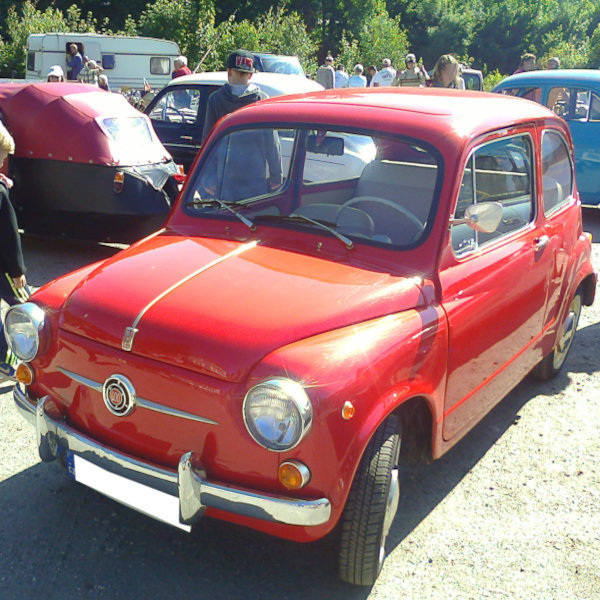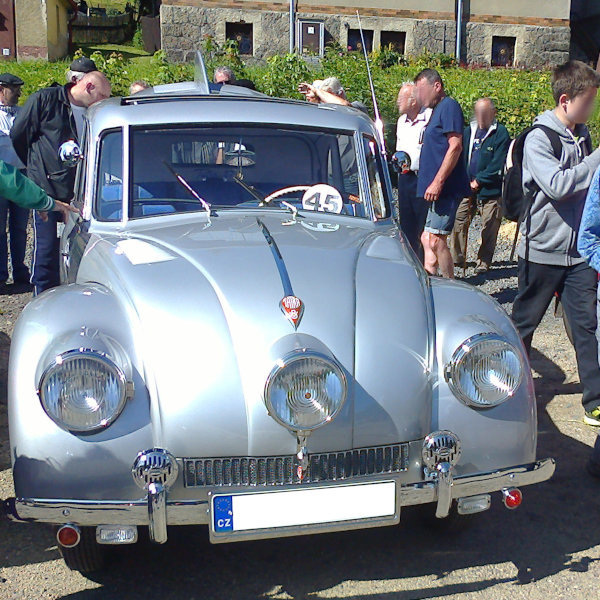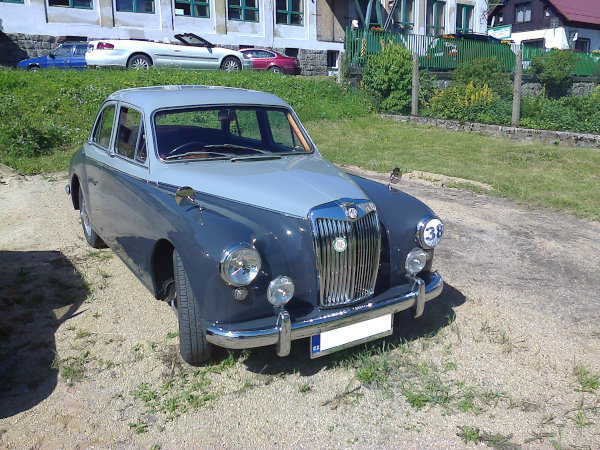
The Josefuv Dul Car Show, 2015
This set of photos delayed me from posting to iPernity for literally eight years, but I'm back now. Going through these, getting rid of most of them, was daunting, and I've had many other projects outside of photography over the years. In any case, I'm back for now, and after I finish this album there will probably be more, although I don't know how many. I hope you all enjoy it!
This car sh…
(read more)
--/--/----
Tatra 57 at the Josefuv Dul Car Show, Liberecky kraj, Bohemia(CZ), 2015
Here's a much better look at the grilless front end of the Tatra 57. Although this design was changed for the 1937 model year (Tatra 57's stayed in production until 1949), the initial omission was probably down to the 1932-1936 Tatra 57's 1155cc flat-4 engine, that like many flat or "boxer" engines, was air cooled. Presumably, the grille was added from 1937 onwards because air-cooled engines can still benefit from the improved airflow that a grille provides, even if there isn't a radiator. For a comparison, think of a laptop, and the need to provide adequate airflow. Generally, laptops with a lot of grilles should cool better than ones that don't have any ventilation (and we all know which manufacturers I'm referring to).
--/--/----
Fiat 600 at the Josefuv Dul Car Show, Liberecky kraj, Bohemia(CZ), 2015
When I first saw this car, I assumed it was a Fiat 500, but Fiat, in fact, also built a Fiat 600, which looked very similar, as this one does. The 600 actually predated the second generation of the 500 (which is the one everyone knows) by 2 years. The 500 was actually a scaled-down 600 intended as one of the world's first "city cars" designed to be as small as possible.
The Fiat 600, like the 500, always came with an air-cooled I-4 engine, in a rear/rear layout. The engine was longitudinally mounted behind the rear axle, showing the influence of the Volkswagen Beetle in the design process. Displacement of the engine varied, but was always less than a liter, being available, in various years, at 633cc, 767cc, and 843cc displacement. Predictably, it was a very slow car for 1955, with a top speed of only 95Km/h (59 m.p.h.), much slower than every variant of the Volkswagen Beetle, as well as most other economy cars at the time. For that matter, it was slower than a Ford Model A. Its other numbers are similarly bad, except for that its small size does make it ideal of a city.
As this photo illustrates, the Fiat 600 does have enough of a fan following to be found in preservation, possibly being due to it's somewhat unusual design (although, as I said, the better-known Fiat 500 is based on it).
--/--/----
Skoda 1000MB at Josefuv dul Car Show, Liberecky kraj, Bohemia(CZ), 2015
Skoda built the 1000MB from 1964 to 1969 as their main sedan sold to Czechoslovak workers (orders had to be arranged through the Communist Party, as with most things). It usually came as a four-door, but from 1966 onward a two-door model was also available. Like the Fiat shown earlier, the original design specification demanded a car that weighed less than 700 kilograms (a very low weight) to achieve maximum fuel economy, but the 1000MB was much larger than most cars considered compact at the time. This goal was actually achieved, as a Skoda 1000MB can achieve about 33-38 mpg, which is generally comparable to the Volkswagen Beetle, for example, which is a considerably smaller car (but heavier than the 1000MB, at 800-840 kilograms).
The Skoda 1000MB was also rear/rear layout, an arrangement that was inspired more by the Chevy Corvair than the Volkswagen Beetle or the Fiat 500. You can see the resemblence to the Corvair in both the 1000MB, and even more so in the later Skoda 100 (built 1969-1977). However, unlike the Beetle and the Corvair, the 1000MB used an inline four-cylinder engine, rather than a flat four, initially in 1.0L displacement, but later offered in 1.1L displacement for the 1100MB model.
In spite of some Czechs and Poles saying that the MB stands for "little pains" for "1000 little pains" in Polish and Czech, these cars actually had such a long service life that when I arrived in the Czech Republic in 2005, they were still in general use. It's a similar story to the Lada 1200, which was introduced in the Soviet Union in 1970. The Lada 1200 (as with Ladas generally) has drawn negative reviews ever since it was new, in spite of remaining common on Eastern European streets up to the present day, 35 years after the end of Lada 1200/1300 production.
Today, Skoda 1000MB's are less common outside of preservation, but this is as much due to heavier taxation (on cars without modern emissions controls) than age.
--/--/----
Skoda Felicia at the Josefuv Dul Car Show, Liberecky kraj, Bohemia(CZ), 2015
The Skoda Felicia nameplate has been revived many times by Skoda, but the original production run was in 1959 to 1964. Rather than being a direct predecessor to the 1000MB sedan, the original Felicia was effectively a sports car, something very unusual in the Communist Bloc. It isn't so much that it was fast, of course, as there have been a number of "fake" sports cars made over the years that were slower than normal cars. The 1959 Skoda Felicia (it wasn't clear whether this one was a real 1959, or a later one) originally came with only a 1.1L I-4, with a front-rear layout and water cooling (in contrast to Skodas made from 1964 to 1987, which were largely air-cooled with a rear/rear layout).
The 1.1L engine produced only 50 horsepower (although a 1.2L was introduced in 1961), which resulted in a 24.5 second 0-60 time, very slow, but faster than some Western economy cars of the time, like the Citroen 2CV or the Morris Minor. Whether a Volkswagen Beetle would be faster would depend on the year and engine, but it's clear that a Karmann Ghia would be much faster than a Felicia.
Sports cars are often an image thing, although I'm not sure if I would have wanted to make my only car under Communism a fake sports car without a real, metal roof. On the other hand, public transportation was free in Communist Czechoslovakia, and more extensive than today, so it may not have been for "transportation" to have a sports car, or any car at all.
These cars, like other Communist-era Skodas, have survived very well over the years, although many Felicias have ended up serving in the fleets of antique cars used for tours in Prague, being among the newest cars used. Many 1920's-era Skodas, Tatras, and Fords (mostly Model A's rather than Model T's) make up the bulk of the real antique cars (many of the cars used in the Prague tours are easily-identified fakes), so this makes the Felicias into outliers.
--/--/----
Morgan Plus Four Plus (+4+) at the Josefuv Dul Car Show, Liberecky kraj, Bohemia(CZ), 2015
The Morgan Plus Four Plus (a.k.a. the +4+) was introduced in 1963, but only 26 were built, making this car one of the rarest ones at the Josefuv Dul show. In spite of Morgan usually building cars deliberately designed to look pre-World War II, this one featured more or less modern styling for 1963, arguably copying a bit from Jaguar.
The engine was only a 2138cc I-4 with 110 horsepower, which had actually been sourced from Triumph, rather than built in-house. In fact, many Morgans over the years had Triumph engines before Truimph got out of car building. In spite of Triumphs and Morgans of that era not being very fast (more recent Morgans, in spite of their appearance, have often been very fast, with 0-60 times under 5 seconds), the +4+ was considered good for its day (I haven't been able to find specific data for the +4+ specifically, though). Its low production (due to low sales, rather than a deliberate limit) remains a mystery to automotive historians. It may have been that Morgan buyers specifically wanted a retro car, and the +4+ wasn't it.
--/--/----
Tatra 87 at Josefuv Dul Car Show, Liberecky kraj, Bohemia(CZ), 2015
The Tatra 87 (a.k.a. T87), may have been the most famous car that Tatra produced in the pre-Communist era, with production running from 1936 to 1950, with production actually continuing during World War II. The somewhat sinister reason for this was that it was a very popular car with German officials during the occupation of Czechoslovakia, until it was banned from German government use over safety fears.
Czechs sometimes joked, if privately, that the Tatra 87 was their "secret weapon" since so many Germans were killed in accidents with it (a fact that, oddly, is not an undisputed fact among historians). The reasons for this story (and the German ban, which is well-documented) were both that the Tatra 87 had its weight distribution too far to the rear, a common problem in rear-engined cars, and that it was fast for its time, being capable of over 160Km/h (99 m.p.h.), in an era when only the fastest cars were.
The Tatra 87's engine was actually an 85-horsepower V-8, but the obvious parallel to the Ford flathead end there, as this was a SOHC V-8 with 2969 cc displacement, making it considerably smaller than the Ford 221cid (3.6L) flathead. Another difference was that the Ford flathead, in line with conventional practice, was water-cooled, whereas the Tatra 2.9L SOHC was air-cooled, like other pre-war Tatra engines.
Another dissimilarity was that V-8 Fords, while fast compared to other mass-market cars, could only top out at about 75-84 m.p.h., depending on which year and variant. Hot rods don't count, of course. This difference was due largely to the lower weight, and more sophisticated aerodynamics, of the Tatra. The similarity in appearance to the Volkswagen Beetle also isn't a coincidence, actually, as Ferdinand Porsche studied the Tatra 87 as one of the models for the Beetle.
One more thing that might be worth looking at, if you're interested, is Wikipedia's list of famous (and unexpected) people who drove Tatra 87's, including people like John Steinbeck, King Farouk I of Egypt, and maybe less suprisingly, Felix Wankel, inventor of the Wankel or "rotary" engine used in Mazdas.
en.wikipedia.org/wiki/Tatra_87
--/--/----
1 comment
BMW 328 at the Josefuv Dul Car Show, Liberecky kraj, Bohemia(CZ), 2015
When I spotted this 1930's-era BMW 328 (it wasn't 100% certain what the model year of this one was), I immediately assumed I had found the rarest and most valuable car at the show, although my research now indicates that the Morgan +4+ was actually much rarer. In any event, this well-known sports car was also relatively limited production, with only 464 built.
This generation of the BMW 328 is not to be confused with the popular (and high-volume production) 328 sedan produced today, as the model number is only a coincidence. Although the original BMW 328's history will be forever tainted by its association with interwar Germany, this sports car was one of the most capable of its day. It only had a 1,971cc I-6 engine with three carburetors, and ultimately 79 horsepower, but its 830-kilogram weight meant that this didn't have to matter, especially since its competition mostly didn't offer a better power-to-weight ratio. This was borne out in race results, which can still be reviewed online, including on Wikipedia. The officially-published top speed of the BMW 328 was 150Km/h (93 m.p.h.), notably slower than the Tatra 87, but still faster than most sports cars of its era, and like the Tatra, also faster than a stock V-8 Ford.
--/--/----
MG Magnette ZB at the Josefuv Dul Car Show, Liberecky kraj, Bohemia(CZ), 2015
It's a common misconception that MG Cars (trading under various specific names over the years) only build sports cars. In reality, MG have also been building hatchbacks since the 1982, and sedans ("saloons" in the UK) since 1927.
This MG is a Magnette ZB, which was the saloon manufactured by MG from 1956 to 1958, replacing the earlier, but similar, Magnette ZA. The ZB used an Austin-made BMC B-Series 1.5L I-4 with dual carburetors that produced only 64 horsepower. This meant that the ZB ultimately wasn't very fast, but not being a sports car, the pressure for higher performance was arguably off, and indeed many 1950's-era British cars, including sports cars, were very slow.
One innovative feature for the 1957 model year was the option of one of the world's first semi-automatic transmissions. This is more significant in hindsight, as semi-automatics are now the standard of the automotive world (at least for internal-combustion-engined cars), even if they took decades to catch on.
--/--/----
Skoda 100 at Josefuv Dul Car Show, Liberecky kraj, Bohemia(CZ), 2015
As mentioned in my caption for the Skoda 1000MB, the 1000MB was replaced in Skoda's lineup in 1970 by the 100, seen here. The 100 was very (visibly) similar to the 1000MB, but incorporated a number of improvements, and was sold more extensively in the West, a trend that was to continue over the years regardless of politics, at least in Europe.
The 100 was so-named in reference to its 1.0L I-4 engine, and in fact it was also possible to order a 110 model, that came with a 1.1L I-4. These engines, like their predecessors on the 1000MB and 1100MB, were air-cooled, and mounted in a rear/rear layout. The physical appearance of these cars, perhaps as a consequence, resembles that of later Chevy Corvairs, which were exactly contemporary with them.
In an unusual development for a Communist-run company, two race versions were also built, these being the 120S and the 130RS, both of which are understandably rare today, and easy to confuse with later models due to the numbering. These cars are actually fast by Communist standards, being capable of 7-second 0-60 times (and in all likelihood, they were even faster once prepped for racing).
While Skoda 100 production ended in 1977, the 110R coupe survived until 1980. All other cars built in the 100 series were actually sedans, with the exception of the 130RS, which used the same coupe body (more or less) as the 110R.
In any case, to make a long story short, when the 100 was exported to Western countries, it often got bad reviews for both performance and handling. However, as with the 1000MB, these cars have enjoyed much longer lifespans than most cars (at least from a Western perspective). Although they're not as common as they used to be, in the Czech Republic they can still be found in regular use from time to time. I'm not clear on how many Chevy Corvairs you would still see as daily drivers, by comparison.
Jump to top
RSS feed- Latest items - Subscribe to the latest items added to this album
- ipernity © 2007-2024
- Help & Contact
|
Club news
|
About ipernity
|
History |
ipernity Club & Prices |
Guide of good conduct
Donate | Group guidelines | Privacy policy | Terms of use | Statutes | In memoria -
Facebook
Twitter










